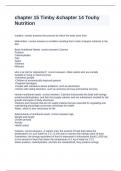chapter 15 Timby &chapter 14 Touhy
Nutrition
nutrition correct answers the process by which the body uses food
Malnutrition correct answers a condition resulting from a lack of proper nutrients in the
diet
Basic Nutritional Needs correct answers Calories
Proteins
Carbohydrates
Fats
Water
Vitamins
Minerals
who is at risk for malnutrition? correct answers -Older adults who are socially
isolated or living on fixed incomes
-Homeless people
-Children of economically deprived parents
-Pregnant teenagers
-People with substance abuse problems, such as alcoholism
-Clients with eating disorders, such as anorexia nervosa and bulimia nervosa
Human nutritional needs correct answers -Calories that provide the body with energy
protienscarbohydrates, and fats that supply calories and are substances needed for the
growth and repair of body structures
Vitamins and minerals that do not supply calories but are essential for regulating and
maintaining physiologic processes necessary for health
Water, which is also necessary for life
determinants of nutritional needs correct answers Age
Weight and height
Growth periods
Activity
Health status
Calories correct answers -A calorie (cal), the amount of heat that raises the
temperature of 1 g of water by 1°C, is one way to express the energy value of food.
Sometimes, the energy equivalent of food is expressed in kilocalories (kcal) (1,000 cal,
or the amount of heat that raises the temperature of 1 kg of water by 1°C).
When proteins, carbohydrates, and fats are metabolized, they produce energy
, -The number of calories a person needs depends on age, body size, physical condition,
and physical activity.
-Average adult male needs 2000 to 3000 calories per day
-Average adult female needs 1600 to 2400 calories per day
-Proteins yield 4 calories/g
-Carbohydrates yield 4 calories/g
-Fats yield 9 calories/g
Geri Considerations correct answers Because older adults need fewer calories, it is
important to teach about the consumption of nutrient-dense foods such as meat, fruits,
vegetables, soy-based proteins, dairy products, and whole-grain foods.
Proteins correct answers -Nutrient composed of amino acids, which are chemical
compounds composed of nitrogen, carbon, hydrogen, and oxygen.
-Amino acids are responsible for building and repairing cells
-Essential amino acids, which are protein components that must be obtained from food
because the body cannot synthesize them
-Nonessential amino acids, are protein components manufactured within the body.
"Nonessential" refers to the fact that these amino acids are not dependent on dietary
intake, not that they are unnecessary for health.
-The body uses proteins primarily to build, maintain, and repair tissue. The body spares
protein from being used for energy as long as calories are available from carbohydrates
and fats.
protein sources correct answers milk, meat, fish, poultry, eggs, soy, legumes (peas,
beans, and peanuts), nuts, and components of grains
Complete protein sources correct answers animal proteins (meat, fish, poultry, milk,
cheese, and eggs)
proteins that contain adequate amounts and proportions of all the essential amino acids
incomplete protein sources correct answers plant proteins (grains, legumes, nuts,
seeds, and vegetables)
proteins that contain insufficient quantities of one or more essential amino acids
Protein Complimentation correct answers combining plant sources of protein so that
amino acids that are missing in one is compensated by those contained in another
Carbohydrates correct answers Primary source of quick energy
-Classified by sugar content
monosaccharides
disaccharides
polysaccharides
-are nutrients that contain molecules of carbon, hydrogen, and oxygen, and are
generally found in plant food sources.




